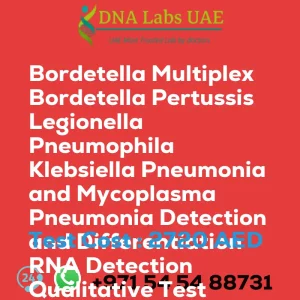Pseudomonas Aeruginosa RNA Detection Qualitative Test
Cost: AED 1160.0
Symptoms, Diagnosis, and Test Details
At DNA Labs UAE, we offer the Pseudomonas Aeruginosa RNA Detection Qualitative Test. This test is used to determine the presence or absence of Pseudomonas aeruginosa RNA in a sample. It is a viral test performed using a molecular technique called reverse transcription-polymerase chain reaction (RT-PCR).
Test Components
Price: AED 1160.0
Sample Condition
Sputum or throat swabs in cystic fibrosis patients, water samples
Report Delivery
4th Working Day – Email: 48 hours, On phone: 36 hours
Method
Real Time RT-PCR
Test Type
Viral
Doctor
Physician
Test Department
Genetics
Pre Test Information
Before the test, you will need to sign a consent document and bring any clinical history of the patient for the Pseudomonas Aeruginosa (RNA Detection) Qualitative Test.
Test Procedure
The qualitative test for detecting Pseudomonas aeruginosa RNA involves the following steps:
- Sample Collection: Collect a sample from the suspected source, such as a wound, sputum, or urine. Ensure proper aseptic technique during sample collection to avoid contamination.
- RNA Extraction: Extract the RNA from the sample using a commercial RNA extraction kit. This step involves breaking open the cells and isolating the RNA from other cellular components.
- Reverse Transcription: Convert the extracted RNA into complementary DNA (cDNA) using a reverse transcriptase enzyme. This enzyme synthesizes a single-stranded cDNA from the RNA template.
- Polymerase Chain Reaction (PCR) Setup: Set up a PCR reaction mixture containing the cDNA, primers specific to Pseudomonas aeruginosa RNA, nucleotides, and a DNA polymerase enzyme. The primers are designed to bind to specific regions of the Pseudomonas aeruginosa RNA.
- PCR Amplification: Perform PCR amplification by subjecting the reaction mixture to a series of temperature cycles. These cycles involve denaturation of the DNA template, primer annealing, and DNA synthesis. The PCR amplification exponentially increases the amount of Pseudomonas aeruginosa RNA if it is present in the sample.
- Gel Electrophoresis: Analyze the PCR products using gel electrophoresis. Load the PCR products onto an agarose gel and apply an electric current. The DNA fragments will migrate through the gel, and their sizes can be visualized under UV light.
- Result Interpretation: If a specific DNA band of the expected size (corresponding to the Pseudomonas aeruginosa RNA target) is observed on the gel, it indicates the presence of Pseudomonas aeruginosa RNA in the sample. Absence of the band suggests the absence of Pseudomonas aeruginosa RNA. It is important to note that this qualitative test only determines the presence or absence of Pseudomonas aeruginosa RNA and does not provide information about the quantity or viability of the bacteria. Further tests, such as culture-based methods, may be required for a comprehensive diagnosis.
For more information or to schedule a Pseudomonas Aeruginosa RNA Detection Qualitative Test, please contact DNA Labs UAE.
| Test Name | Pseudomonas Aeruginosa RNA Detection Qualitative Test |
|---|---|
| Components | |
| Price | 1160.0 AED |
| Sample Condition | sputum or throat swabs in cystic fibrosis patients, water samples. |
| Report Delivery | 4th Working Day Email : 48 hours.On phone : 36 hours |
| Method | Real Time RT- PCR |
| Test type | Viral |
| Doctor | Physician |
| Test Department: | Genetics |
| Pre Test Information | Need to sign Consent document and bring any clinical history of patient forPseudomonas Aeruginosa (RNA Detection) QualitativeTest |
| Test Details |
The qualitative test for detecting Pseudomonas aeruginosa RNA involves the use of a molecular technique called reverse transcription-polymerase chain reaction (RT-PCR). This test is used to determine the presence or absence of Pseudomonas aeruginosa RNA in a sample. Here is a step-by-step procedure for performing the qualitative test: 1. Sample Collection: Collect a sample from the suspected source, such as a wound, sputum, or urine. Ensure proper aseptic technique during sample collection to avoid contamination. 2. RNA Extraction: Extract the RNA from the sample using a commercial RNA extraction kit. This step involves breaking open the cells and isolating the RNA from other cellular components. 3. Reverse Transcription: Convert the extracted RNA into complementary DNA (cDNA) using a reverse transcriptase enzyme. This enzyme synthesizes a single-stranded cDNA from the RNA template. 4. Polymerase Chain Reaction (PCR) Setup: Set up a PCR reaction mixture containing the cDNA, primers specific to Pseudomonas aeruginosa RNA, nucleotides, and a DNA polymerase enzyme. The primers are designed to bind to specific regions of the Pseudomonas aeruginosa RNA. 5. PCR Amplification: Perform PCR amplification by subjecting the reaction mixture to a series of temperature cycles. These cycles involve denaturation of the DNA template, primer annealing, and DNA synthesis. The PCR amplification exponentially increases the amount of Pseudomonas aeruginosa RNA if it is present in the sample. 6. Gel Electrophoresis: Analyze the PCR products using gel electrophoresis. Load the PCR products onto an agarose gel and apply an electric current. The DNA fragments will migrate through the gel, and their sizes can be visualized under UV light. 7. Result Interpretation: If a specific DNA band of the expected size (corresponding to the Pseudomonas aeruginosa RNA target) is observed on the gel, it indicates the presence of Pseudomonas aeruginosa RNA in the sample. Absence of the band suggests the absence of Pseudomonas aeruginosa RNA. It is important to note that this qualitative test only determines the presence or absence of Pseudomonas aeruginosa RNA and does not provide information about the quantity or viability of the bacteria. Further tests, such as culture-based methods, may be required for a comprehensive diagnosis. |








